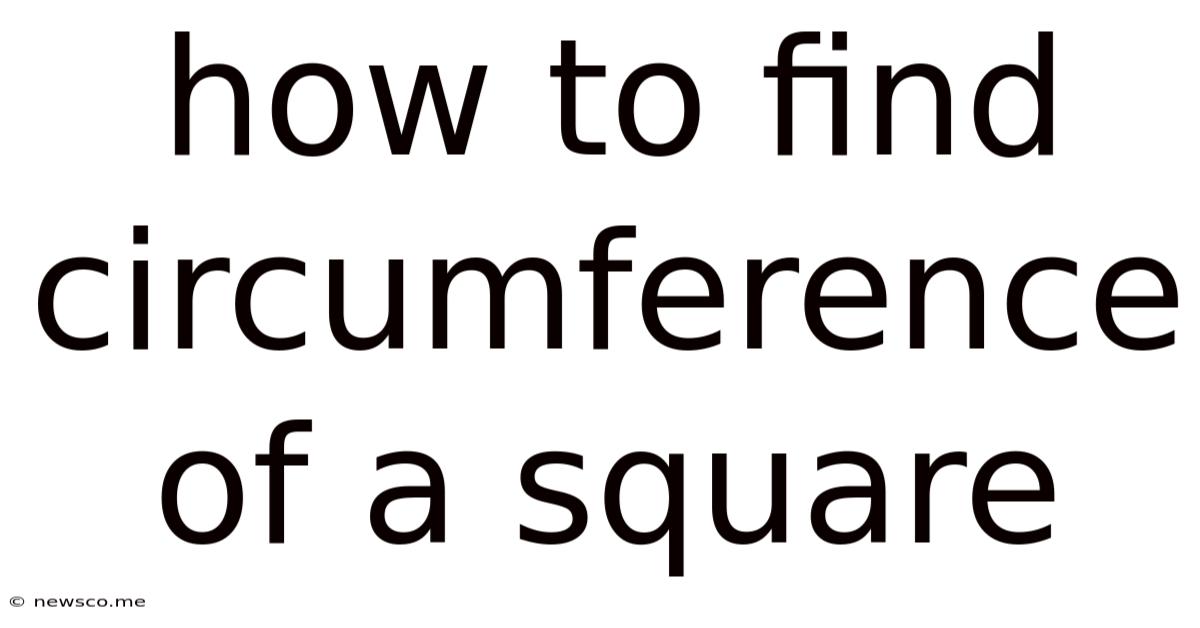How To Find Circumference Of A Square
News Co
May 07, 2025 · 4 min read

Table of Contents
It's impossible to find the circumference of a square. A square, by definition, has four sides and four right angles. The term "circumference" specifically refers to the distance around a circle. Squares, on the other hand, have a perimeter. This article will explore the concept of perimeter, how to calculate it for squares, and clarify the difference between perimeter and circumference. We will also delve into related geometrical concepts to provide a comprehensive understanding.
Understanding the Difference: Perimeter vs. Circumference
Before we proceed, it's crucial to understand the difference between perimeter and circumference. This fundamental distinction is often a source of confusion.
-
Circumference: This term exclusively applies to the distance around the edge of a circle. It's a curved line, and its calculation involves the use of pi (π), an irrational number approximately equal to 3.14159. The formula for circumference is C = 2πr, where 'r' represents the radius of the circle.
-
Perimeter: This term refers to the total distance around the boundary of any closed two-dimensional shape. This includes polygons like squares, rectangles, triangles, and more complex shapes. For polygons, the perimeter is simply the sum of the lengths of all its sides.
Therefore, the question of "how to find the circumference of a square" is fundamentally flawed. Squares don't have a circumference; they have a perimeter.
Calculating the Perimeter of a Square
A square is a regular polygon with four equal sides. This characteristic simplifies the calculation of its perimeter significantly.
The Formula
The perimeter (P) of a square is calculated using the following formula:
P = 4s
where 's' represents the length of one side of the square.
Step-by-Step Calculation
Let's illustrate this with an example. Suppose we have a square with sides of length 5 centimeters (cm).
-
Identify the side length: s = 5 cm
-
Apply the formula: P = 4s = 4 * 5 cm = 20 cm
-
State the result: The perimeter of the square is 20 centimeters.
Beyond the Basics: Exploring Related Concepts
While the perimeter of a square is straightforward to calculate, understanding related geometric concepts enhances our overall comprehension.
Area of a Square
The area of a square represents the space enclosed within its boundaries. The formula for the area (A) of a square is:
A = s²
Using our previous example (s = 5 cm), the area would be:
A = 5 cm * 5 cm = 25 cm²
Squares and Other Polygons
Understanding squares helps us understand other polygons. Squares are a special case of:
- Rectangles: A rectangle is a quadrilateral with four right angles. A square is a special type of rectangle where all sides are equal.
- Parallelograms: A parallelogram is a quadrilateral with opposite sides parallel. A square is a special case of a parallelogram with all sides equal and all angles equal to 90 degrees.
- Rhombuses: A rhombus is a quadrilateral with all four sides equal. A square is a special type of rhombus with all angles equal to 90 degrees.
Diagonal of a Square
The diagonal of a square is a line segment connecting two opposite vertices. Its length can be calculated using the Pythagorean theorem:
d = s√2
where 'd' is the length of the diagonal and 's' is the length of a side.
For our example (s = 5 cm):
d = 5 cm * √2 ≈ 7.07 cm
Squares in Real-World Applications
Squares are ubiquitous in our world. We encounter them in:
- Architecture: Building designs often incorporate squares for their stability and simplicity.
- Art: Squares are fundamental shapes in various artistic styles and compositions.
- Everyday Objects: Many everyday objects, from tiles to playing cards, are square-shaped.
- Games and Puzzles: Squares are integral to many games and puzzles, such as chessboards and Sudoku.
Troubleshooting Common Mistakes
While calculating the perimeter of a square is relatively simple, some common mistakes can occur:
- Confusing perimeter with area: Remember, perimeter is the distance around the shape, while area is the space inside. Don't mix up the formulas.
- Incorrect units: Always include the appropriate units (cm, meters, inches, etc.) with your answer.
- Misinterpreting the side length: Ensure you're using the correct value for the side length of the square.
Advanced Concepts: Squares in Higher Dimensions and Geometry
The concept of a square can be extended beyond two dimensions.
-
Hypercubes: In higher-dimensional spaces, the equivalent of a square is a hypercube. A hypercube in four dimensions is called a tesseract.
-
Tessellations: Squares can perfectly tessellate (tile a plane without gaps or overlaps), making them ideal for covering surfaces. This principle is widely used in various fields, including architecture and design.
Conclusion: Mastering Square Geometry
Understanding the perimeter of a square, and the difference between perimeter and circumference, is a cornerstone of basic geometry. This knowledge extends to various fields and helps us solve practical problems in everyday life and advanced mathematical concepts. While the concept itself is simple, grasping the related geometrical concepts and avoiding common errors will strengthen your overall mathematical abilities. Remember, always clearly define the shape and the measurement you are trying to find to ensure accuracy. The correct term for the distance around a square is the perimeter, not the circumference.
Latest Posts
Related Post
Thank you for visiting our website which covers about How To Find Circumference Of A Square . We hope the information provided has been useful to you. Feel free to contact us if you have any questions or need further assistance. See you next time and don't miss to bookmark.